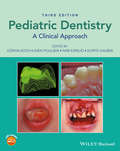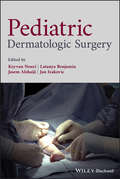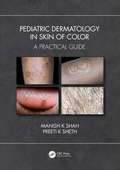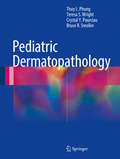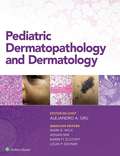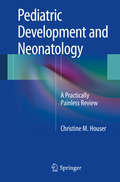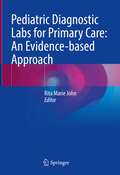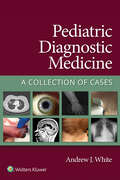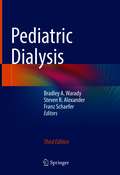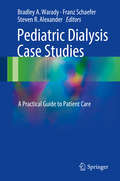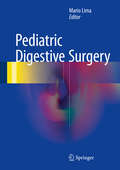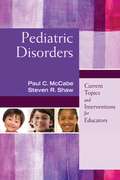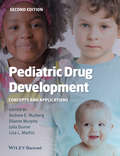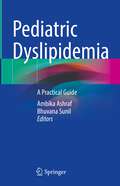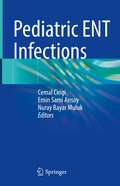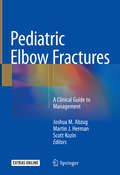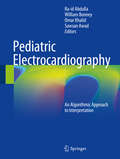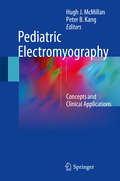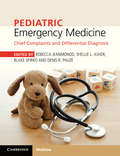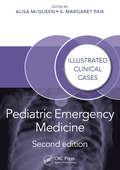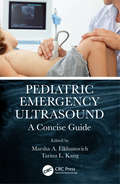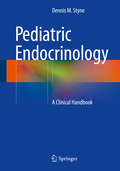- Table View
- List View
Pediatric Dentistry: A Clinical Approach
by Ivar Espelid Goran Koch Sven Poulsen Dorte HaubekNew edition of a leading textbook providing a uniquely clear, comprehensive, and clinical approach to the dental treatment of children and adolescents Offers systematic coverage of all clinical, scientific and social topics relating to pediatric dentistry Thoroughly revised and updated new edition, with an increased focus on evidence based care Includes three new chapters on genetics, child abuse and neglected children, and ethics Pedodontic endodontics is now covered by two chapters - one on primary teeth and one on young permanent teeth Features a companion website with interactive self-assessment questions
Pediatric Dermatologic Surgery
by Keyvan Nouri Latanya Benjamin Jasem Alshaiji Jan IzakovicA complete guide to the surgical techniques used to treat childhood skin conditions Recent advances have expanded the role of pediatric dermatologic surgery in both specialist and primary care settings. However, such surgeries can pose unique challenges to trainees and experienced practitioners alike. Procedures are carried out under local anesthesia and can be a source of distress and concern among young patients. Moreover, child’s skin poses its own set of complicating factors, making the business of performing these procedures especially delicate and precise. This book provides a step-by-step primer on invasive and non-invasive treatments of childhood skin disorders, offering concise and clearly illustrated guidance on current methods and best practices. Addressing conditions’ effects, the impact of recent developments in their treatment, the ethics of operative procedures on children, and multiple treatment options for childhood dermatologic disease, Pediatric Dermatologic Surgery is an indispensable resource for trainee dermatologists and pediatricians, as well as practicing specialists.
Pediatric Dermatology in Skin of Color: A Practical Guide
by Manish K Shah Preeti K ShethThis book focusses on the clinical aspects and management of pediatric skin disorders, especially seen in darker skin types. It includes unique conditions that the authors have encountered in their lifetime with their independent observations and approach to management. Original high-quality images are used to illustrate most dermatoses described in the book enabling a strong visual impression of the discussed diseases. It hopes to provide readers with a blend of evidence and experience based pediatric dermatology. This book aims to be a hands-on manual that can be referred to during a busy practice as it discusses the practical approach to dermatoses. Key Features Focusses on darker skin types. Examines unusual presentations with detailed clinical features. Discusses the ways to differentiate between similar-appearing diseases. Explores approaches to therapy, especially in resource-poor settings. Covers topics with high quality illustrations.
Pediatric Dermatopathology
by Bruce R. Smoller Thuy L. Phung Teresa S. Wright Crystal Y. PourciauThis book provides practicing pathologists, dermatologists, cutaneous oncologists and dermatopathologists with a reference textbook that reviews the clinical and histopathologic features of skin disorders that affect children, along with a discussion of the molecular pathogenesis for each disease as it is currently known. The book includes a concise discussion of the clinical presentation, as well as the histologic and, when appropriate, immunohistochemical features of each disease. The book is divided into two main sections, non-neoplastic and neoplastic skin diseases. Each section is comprised of a series of chapters organized according to histologic findings rather than by clinical classification systems. This will enable the practicing pathologist to browse chapters based upon observation of routine histologic patterns. Each chapter addresses the differential diagnoses of skin disorders with focus on salient histologic characteristics. The text is richly illustrated with over 1000 colorful clinical and histologic photographs for each of the 400 entities discussed. Pediatric Dermatopathology provides a microscope table reference for the practicing pediatric pathologist, general pathologist and dermatopathologist. Further, it will serve as a reference volume for dermatologists, pediatricians and oncologic surgeons.
Pediatric Dermatopathology and Dermatology
by Mark Wick Alejandro A. GruPublisher's Note: Products purchased from 3rd Party sellers are not guaranteed by the Publisher for quality, authenticity, or access to any online entitlements included with the product. Pediatric Dermatopathology and Dermatology is a unique reference highlighting both the histopathology and clinical presentation of common and uncommon pediatric skin disorders. This user-friendly reference is ideal for dermatopathologists and pathologists and of special interest to pediatric dermatologists and general dermatologists. With a global perspective, skin disorders that affect children world-wide are presented. Thousands of full-color histopathology slides and clinical photos accompany concise, templated text for each pediatric skin disorder.
Pediatric Development and Neonatology
by Christine M. HouserOften, information in review books can raise as many questions as it answers. This interferes with the study process, because the learner must either look up additional information or skip ahead without truly comprehending what he or she has read. As an alternative, Pediatric Development and Neonatology: A Practically Painless Review presents bite-sized chunks of information that can be read and processed rapidly, helping learners to stay active while studying to understand and process new information the first time they read it. This book's question and answer format allows for self-testing or study with a partner or a group. The format also facilitates dipping into the book during a few minutes of downtime at the hospital or office. Pediatric Development and Neonatology: A Practically Painless Review is a quick and easy way to master these tricky topics and is suitable for those studying for the pediatric board exam, practicing physicians brushing up on their skills, medical students and pediatric residents doing rotations, and any busy clinician who wants to learn more about these topics while on the go.
Pediatric Diagnostic Labs for Primary Care: An Evidence-based Approach
by Rita Marie JohnThis textbook helps nurses, physician assistants, medical students and residents to order appropriate tests and understand how to interpret them to improve their diagnostic reasoning. Children are not like adults, and interpreting of the results of their diagnostic laboratory tests requires knowledge of the biochemical and metabolic differences. Using a combination of information, questions and case studies, the book allows readers to gain an understanding of the key concepts of sensitivity, specificity, and positive and negative predictive values, as well as the indications for diagnostic lab tests. This textbook presents the state of art in testing across body systems and guidance on how to order and interpret diagnostic laboratory tests in pediatric patients. Each chapter includes learning objectives, tables and figures, as well as questions and references for further learning. This textbook provides an update for clinicians and is a valuable learning tool for students and new clinicians. .
Pediatric Diagnostic Medicine: A Collection of Cases
by Andrew WhiteUsing a practical, case-based presentation, Pediatric Diagnostic Medicine helps you develop diagnostic skills, gain further knowledge through interesting cases, and improve critical thinking to reach a correct diagnosis. Dr. Andrew J. White, vice chair of education and director of the residency program at Washington University in St. Louis, presents dozens of real-world cases highlighted by full-color photographs. This unique case collection is an invaluable resource for pediatricians, residents, hospitalists, physician assistants, nurse practitioners, and anyone who provides care to children.
Pediatric Dialysis
by Bradley A Warady Steven R. Alexander Franz SchaeferSince the inaugural publication of Pediatric Dialysis in 2004, a wide range of advances have taken place in dialysis-related care, leading to a wealth of new knowledge in the field. Pediatric Dialysis, Second Edition brings this knowledge together to provide the most comprehensive source of state-of-the-art information on the dialysis of infants, children and adolescents. With new chapters, updated chapters and references, and contemporary, unique perspectives from authors who are leaders in the global pediatric nephrology community, Pediatric Dialysis, Second Edition is, once again, an authoritative reference that will facilitate best practices in both acute and chronic dialysis. Experienced clinicians and trainees alike will find Pediatric Dialysis, Second Edition not only another valuable contribution to the literature but an indispensable guide to managing their pediatric patients on dialysis.
Pediatric Dialysis
by Steven R. Alexander Franz Schaefer Bradley A. WaradyThe optimal management of children who receive dialysis therapy requires a thorough understanding of the multidisciplinary nature of their treatment. The multiple organ systems that are often impacted by acute and chronic impairment of kidney function makes the care of this patient population highly complex. This 3rd edition of Pediatric Dialysis provides authoritative and comprehensive information on all aspects of dialysis-related care for children to assist the clinician in achieving the best possible patient outcomes. Like the two preceding editions, the 3rd edition enlists experts from North America, South America, Europe, and Asia to provide their perspectives on virtually all issues pertaining to dialysis-related management for children, based on years of clinical and research experience. The book contains sections on all essential topics including when to initiate dialysis, peritoneal dialysis, hemodialysis, managing secondary complications, nutritional therapy, drugs and dialysis, dialysis outcomes, and transition to adult care. Each chapter has been thoroughly updated in terms of content and references. The book also includes several new chapters on topics such as remote patient monitoring, acute kidney injury management in the developing world, and antibiotic stewardship in the dialysis unit, maintaining the text's preeminent status as a worldwide source for pediatric dialysis care.
Pediatric Dialysis Case Studies
by Steven R. Alexander Franz Schaefer Bradley A. WaradyEdited by the same team that developed the successful Pediatric Dialysis and its second edition, this text features clinical management principles that are integral to the care of children receiving chronic dialysis. Each chapter is introduced by a case presentation that serves as the basis for key learning points that are clinically applicable and presented in a succinct manner. The topics included in Pediatric Dialysis Case Studies cover virtually all aspects of pediatric dialysis care and represent the efforts of an international group of experts with firsthand clinical expertise from all disciplines represented in the pediatric dialysis team. This resource is certain to help the clinician achieve improved outcomes for these often complex patients.
Pediatric Digestive Surgery
by Mario LimaThis book presents and explains the latest developments in surgery for congenital digestive tract malformations, tumors, abdominal trauma, and the most important acquired digestive disorders. Particular attention is paid to minimally invasive and innovative techniques. In addition to clear descriptions of the surgical procedures that highlight useful tips and tricks, for each condition the clinical presentation is well illustrated and information is provided on pathogenesis. The book also includes general chapters that address the anatomy of the abdomen in children, diagnostic issues, the problem of clinical nutrition, and other aspects of management in pediatric patients with gastrointestinal pathologies. Pediatric Digestive Surgery will serve as a comprehensive and up-to-date reference for all pediatric surgeons. It will provide the trainee with easily understood, concise guidance while offering the more experienced surgeon valuable updates on the latest thinking and practice in the field.
Pediatric Disorders: Current Topics and Interventions for Educators
by Steven R. Shaw Dr Paul C. McCabeThe educator’s go-to reference for important pediatric health topics! Based on up-to-date research, this volume outlines the most current and urgent pediatric issues affecting schools today. Written for school psychologists, counselors, administrators, and teachers, this easy-to-understand resource covers: <p><p> Schools as partners in health care delivery, including health care delivery trends and collaborations between educators and medical professionals <p> Current issues in pediatric disorders and treatments, such as childhood immunizations, shaken baby syndrome, sleep problems, and pediatric HIV <p> Prevention and wellness intervention for childhood obesity, low-level aggression in the schools, and accident prevention
Pediatric Disorders: Current Topics and Interventions for Educators
by Paul C. Mccabe Steven R. ShawMedical issues in schools are a growing reality. In addition to teaching academic skills, educators now play an integral part in comprehensive health care delivery for children. Based on current research, this volume outlines the most current and urgent pediatric issues affecting schools today. Written for school psychologists, counselors, administrators, and teachers, this easy-to-understand resource covers: -Schools as partners in health care delivery, including health care delivery trends and collaborations between educators and medical professionals -Current issues in pediatric disorders and treatments, such as childhood immunizations, shaken baby syndrome, sleep problems, and pediatric HIV -Prevention and wellness intervention for childhood obesity prevention, low-level aggression in the schools, and accident prevention Featuring case studies, classroom strategies, discussion questions, glossaries, and handouts, Pediatric Disorders provides valuable information to practitioners involved in providing differentiated instruction and educational accommodations, collaborating with families, working with the community, and influencing policy.
Pediatric Drug Development
by Lisa L. Mathis Julia Dunne Dianne Murphy Andrew E. MulbergPediatric Drug Development, Second Edition, encompasses the new regulatory initiatives across EU, US and ROW designed to encourage improved access to safe and effective medicines for children. It includes new developments in biomarkers and surrogate endpoints, developmental pharmacology and other novel aspects of pediatric drug development.
Pediatric Dyslipidemia: A Practical Guide
by Ambika Ashraf Bhuvana SunilPediatric lipidology is a relatively new field of pediatrics. Premature cardiovascular diseases account for 30% of mortality in the United States. There is a heightened awareness regarding early recognition, prevention and management of childhood dyslipidemia. This book fulfils the need for a concise, quick-reference guide on clinical approach to the management of pediatric lipid disorders. Rational and optimal medical practice approaches are outlined throughout the text. Current clinical guidelines for treatment of genetic and acquired pediatric dyslipidemias are reviewed with an emphasis on new data and novel therapeutic options. This book is aimed to guide clinical decisions and improve care of at-risk youth in the primary prevention of premature atherosclerotic cardiovascular disease. Written by experts in the field, Pediatric Dyslipidemia includes the most up-to-date scientific and clinical information for pediatricians, endocrinologists, primary care practitioners and any other medical practitioners treating children with dyslipidemia.
Pediatric ENT Infections
by Cemal Cingi Nuray Bayar Muluk Emin Sami ArısoyThe book provides a comprehensive and up-to-date overview of pediatric ENT infections. It brings together the experience of authors from more than 30 countries and aims to provide a broader understanding of the prevention and treatment of infectious diseases in children, that will likely lead to improve their health globally. In addition to new infections like COVID-19, the work reviews the latest treatments modalities. The list of topics ranges from basic to very advanced and the book will be therefore an invaluable resource for ENT and pediatrics trainees and students, as well as for experienced practitioners in these fields.
Pediatric Elbow Fractures: A Clinical Guide To Management
by Martin J. Herman Joshua M. Abzug Scott KozinThis unique text focuses entirely on the treatment of pediatric elbow fractures, which encompass the vast majority of operative cases for pediatric fracture care, and which can be challenging to even the most experienced surgeon. The book opens with a survey of the basic anatomy and development of the elbow, as well as examination and imaging techniques. Both acute and chronic fractures are then discussed in detail, beginning with a brief outline of the epidemiology, classification, and work-up of each fracture, but the main focus will be on providing a master’s approach to the surgical treatment of these injuries, including supracondylar fractures, capitellar shear fractures, elbow dislocations, Monteggia fracture dislocations, and cubitus varus and valgus, among others. Numerous photographs, figures and videos will enable the orthopedic surgeon, hand surgeon, and trauma surgeon to be fully prepared to treat any of these fractures.
Pediatric Electrocardiography
by Ra-Id Abdulla William Bonney Omar Khalid Sawsan AwadThis book elucidates the process of reading electrocardiograms (ECGs) in children. It provides a structured, step-by-step guide for interpreting ECGS using algorithms, which allow clinicians to decipher the data within these tracings and establish differential diagnoses. The book also presents actual high-definition ECG tracings, which are annotated and highlighted to demonstrate the issues discussed. Topics include cellular electrophysiology changes and electrocardiography and disorders such as axis abnormalities, heart rate and rhythm disturbances, hypertrophy, conduction abnormalities, and fetal arrhythmias. Clinical scenarios with answers provide real-life examples of how pediatric patients present, their ECGs, and treatment methodology. Pediatric Electrocardiography: An Algorithmic Approach is a valuable resource for pediatricians, family medicine physicians, cardiologists, and medical students.
Pediatric Electromyography
by Hugh J. Mcmillan Peter B. KangThis book describes how to perform nerve conduction studies and electromyography in children, and explains the relevant physiology and anatomy crucial to making a diagnosis. Relevant case presentations are included to aid learning, and the authors also focus on the practical applications of the test results, including discussions of major neuromuscular diseases amenable to diagnosis via electromyography. Pediatric Electromyography: Concepts and Clinical Applications is aimed at residents, technologists and staff pediatric neurologists, as a practical guide and exam study guide.
Pediatric Emergency Medicine: Chief Complaints and Differential Diagnosis
by Rebecca Jeanmonod Shellie Asher Blake Spirko Denis R. PauzéPediatric patients are a unique subset of emergency patients, making up about one-quarter of all emergency department visits. Textbooks regarding the care of pediatric patients are almost universally organized by organ system, which does not facilitate an efficient diagnosis. Taking a case-based approach, Pediatric Emergency Medicine: Chief Complaints and Differential Diagnosis is arranged by chief complaint, using real patient scenarios to help the reader work through the inductive and deductive reasoning needed to assess, evaluate, treat, and disposition pediatric patients with urgent complaints. Cases are structured in the way in which they are presented during medical care, allowing practitioners to become comfortable with the general structure of case presentations: chief complaint, HPI, PMH, ROS, exam, and ancillary studies. This volume also discusses disease processes and their differentiations, providing in-depth knowledge regarding current standards of diagnosis and care.
Pediatric Emergency Medicine: Illustrated Clinical Cases, Second Edition (Illustrated Clinical Cases)
by Alisa McQueen S. PaikThis book includes 200 clinical cases which present as emergencies. Congenital and acquired conditions affecting all body systems in infants and children are covered, including allergy, abuse, burns, fractures and other trauma, feeding problems, foreign bodies, genetic disorders, infections, poisoning, haematology, oncology, and much more. Cases appear in random order, reflecting actual practice in emergency medicine, and reinforcing skills in investigation, diagnosis, and treatment. It is superbly illustrated with high-quality radiographic images and photographs and is indispensable for all health professionals dealing with emergencies involving children.
Pediatric Emergency Ultrasound: A Concise Guide
by Marsha A. Elkhunovich Tarina L. Kang Courtney Brennan Kathryn Pade Rashida Campwala Jessica Rankin Kristin BeronaThis concise, portable manual provides practitioners and future practitioners with a basic guide to pediatric emergency ultrasound, enabling them to learn the fundamentals of bedside ultrasound and use these to refresh their skills prior to, or when, performing it on a patient.
Pediatric Emergency and Critical Care Ultrasound
by Stephanie J. Doniger MD RDMS FAAP FACEPEmergency bedside ultrasound assessment is well established for adult patients, but has only recently been introduced into everyday clinical practice for the care of pediatric patients. Pediatric Emergency Critical Care and Ultrasound is a concise, practical text which explains the principles of ultrasound, its diagnostic application in all organ systems and its use as a procedural adjunct. Both well-established and innovative applications are described, assisting the practitioner in incorporating ultrasound into daily practice, facilitating patient care and decreasing radiation exposure. Case studies and abundant illustrations enable the reader to study the appropriate techniques in detail and learn from real examples from the pediatric emergency department and intensive care unit. Pediatric Emergency Critical Care and Ultrasound is the first comprehensive bedside ultrasonography resource focusing on pediatric patients and is essential reading not only for pediatric emergency medicine subspecialists but for all emergency physicians, intensivists/critical care physicians and pediatricians.
Pediatric Endocrinology
by Dennis M. StyneThis text provides a concise, straightforward and clearly written approach for the evaluation of common topics in pediatric endocrinology. Pediatricians, family physicians, residents, fellows and medical students will benefit from the discussion of endocrine physiology and its application to common clinical practice. The text presents the major signs and symptoms and the diagnosis and management of pediatric endocrine disorders. The information presented can prepare a provider for communication with parents of a child with an endocrine condition and may allow the practitioner to avoid an unnecessary consultation. The concepts covered in the text are designed to address the first 10 headings in the content outline of the Sub-board of Pediatric Endocrinology of The American Board of Pediatrics with varying degrees of specificity. The Suggested Reading sections at the conclusion of each chapter direct the reader to outstanding larger and more detailed texts, manuscripts and websites which offer increased detail.
